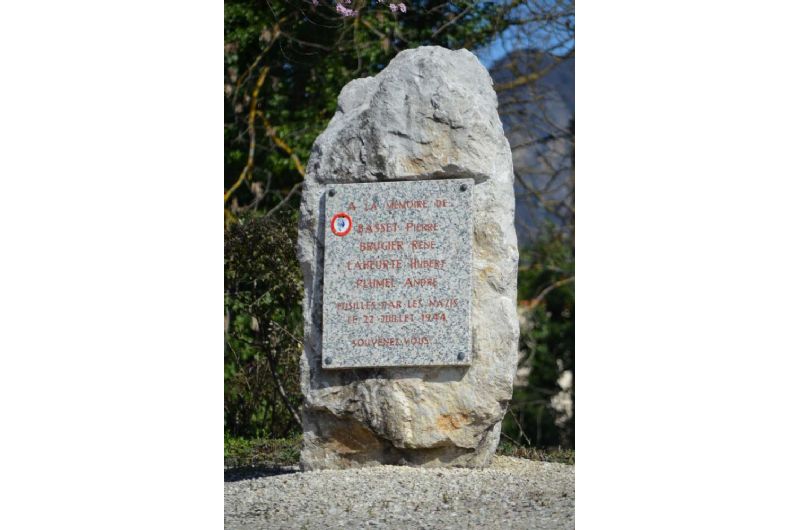Stele of the Die shootings
☨ Pierre BASSET
☨ René BRUGIER
☨ Hubert LAHEURTE
☨ André PLUMEL
Shot on July 22, 1944
Despite the efforts of the Resistance in the Drôme valley, the Germans of the "Kampfgruppe Zabel " composed of a battalion of the 9th armored division and an "Ostbataillon ", are approaching Die. The convoy of wounded from the Vercors hospital, coming from Saint-Martin, arrives in Die on the night of the 21st to the 22nd. The hospital's Mother Superior warned of the imminent arrival of the Germans, forcing the group to return to the massif and take refuge in the Grotte de la Luire. During the night, Doctor Rigal and the religious nurses evacuate all transportable patients from the hospital.
On July 22, the Germans enter Die.
To create and maintain a climate of terror, they move around the town and fire at all times, even at night. A curfew was introduced, and people could only leave the city with a pass. The population is panic-stricken, fearing reprisals, hostage-taking and executions. Monsieur Petit and Abbé Muller, two people from Lorraine, act as interpreters and try to appease the occupiers. German airplanes overfly Die and drop four bombs; one kills 30-year-old Miss Germaine Elluin.
On Sunday July 23 at 10 a.m., Camille Buffardel, of the Buckmaster Roger network, industrialist and deputy mayor, is shot in Place Saint-Pierre and his Clairette cellar is looted. The same day, his brother Édouard is shot dead in Aix-en-Diois. Dr. Paul-Élie Kroll (Kraul?) and his son Maurice, Jewish refugees in Die, were shot dead on the Placette, as was 22-year-old Pierre Chérissol near La Barrière. On the banks of the Drôme river, they kill second lieutenant Victor Vermorel ("Vallin"), wounded at Vassieux, who had tried to flee but was easily recaptured, carpenter René Brugier, woodcutter Pierre Basset, and Hubert Laheurte, 20. The body of Léon Livache, executed while trying to return home to Romeyer, will be run over by several German vehicles. André Plumel, a woodcarver, is shot dead at the Griotte bridge in Die.
On Monday, July 24, a German detachment and a Milice platoon storm the hospital, where they arrest two Jewish refugees from Die, Menahem Skelly Cohen, a merchant from Marseille, and Alexis Feldman, as well as Albert Froment, a clothing merchant from Romans, Marcel Jeanneret, a Vercors maquisard, and Claude Lieber, a 22-year-old Jewish Resistance fighter from Grenoble, whom they massacred in the prison along with the Jew Albert Peters, taken from the Château de Salières. The latter, aged 51, of Austrian origin, a former opera singer and orchestra conductor in Berlin, had come to France in 1933, interned with the 352nd GTE (Groupement de travailleurs étrangers) in Crest, and had been seconded to the Audra furniture factory in Die. He was shot dead by the militia killer "Georges", who had a habit of quickly grabbing his camera to take a snapshot of his collapsing victim.
The hospital secretary, Yvette, was able to use false papers to save three wounded who had remained there, but the fourth, a wounded member of the Brentrup company from Crest, Jean Rousset, 19, wounded on July 20 at Vaunaveys, and evacuated to the hospital in Die. A few hours later, he was shot in the back of the head by Halperson, a dentist from La Motte-Chalancon dressed as a German officer, who had infiltrated the Resistance. The hospital's compromised nuns were interrogated, then lined up in front of a wall to await their execution, which was averted in extremis thanks to the negotiation of Abbé Bossan and his vicar Abbé Muller. They were locked up and not released until the following evening.
All Die residents over the age of 14 were summoned to the Place de l'Évêché. At 2 p.m., in front of German officers strolling by with their badines in hand, militia leader "François" makes a speech: "I'm the father of four children, my father died in the 1914-18 war, I fought in the 1939-40 war, so I'm a good Frenchman... I'm not for the Germans, I'm with the Germans, against the Jews, the Communists, the terrorists". He casts anathema on Die, rebel town, guilty town. And he invites us to follow in the footsteps of the German order.
On July 27, two Jewish resistance fighters are executed in turn by militiamen: Vidal or Nadal Ramis, 24, from Vienne (Isère), and Charles Touch-Laberche, from Nice arrested at Pont-de-Quart and imprisoned in Die.
July 30: posters posted in Die warn the population: "All those who by their activity have favored the maquis will have their property confiscated, their homes destroyed, their lives threatened".
July 31: at the prisonthe miliciens execute four young maquisards caught in Romeyer where they were hiding, after the dispersal order from the Vercors: Alphonse Canovas, 22, Henri Gagnol, Jean Ordassière, 21, and Humbert Pedoyat, 20. As one of them didn't die on the spot, a militiaman lashed out at the body, shouting "you don't want to die, you dirty Spaniard!" because the poor devil had confessed during interrogation that his mother was Spanish. The militiamen stuck a poster on the city walls that began: "
This climate of terror lasted a fortnight: on August 7, the Germans and militiamen left Die.
Author: Robert Serre
Photo credit and contribution: Sylvaine Laborde-Castex
Photo credit and contribution: Sylvaine Laborde-Castex

